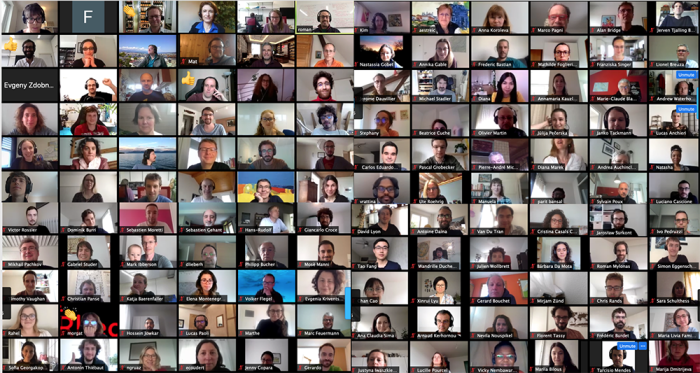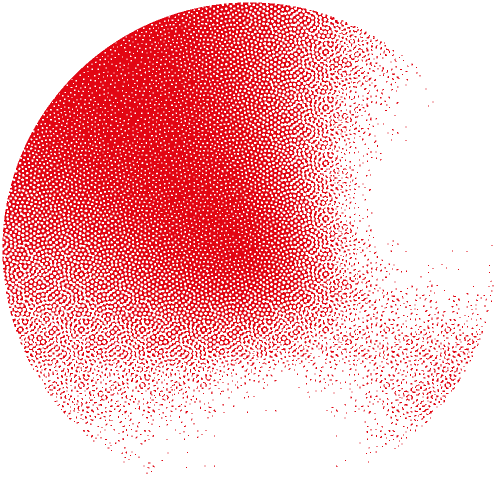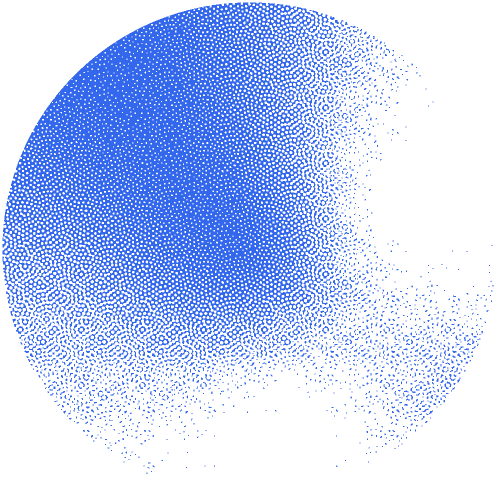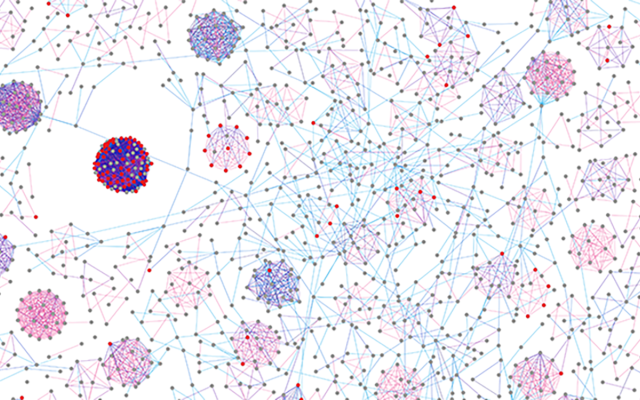What are the latest computational advances to better understand diseases or ecosystems? How are bioinformaticians facing the COVID-19 crisis? The first virtual edition of our internal conference (8-10 June) has remained true to its ambition to represent the scientific diversity of Swiss bioinformatics. It brought together 390 scientists from across Switzerland’s computational biology and bioinformatics groups, as well as international keynote speakers Victoria Nembaware (Sickle Africa Data Coordinating Centre) and Flora Graham (Nature Briefing). We invite you to discover a wrap-up of highlights from the parallel sessions, the COVID-19 panel discussion and the keynotes - and to watch the recorded talks, most of which could be made public.
What are the SIB Days?
The SIB Days are the internal conference of the SIB Swiss Institute of Bioinformatics, organized every two years. Its ambition? To give a voice to SIB’s 80 Groups across Switzerland, through a diversity of bioinformatics topics, and to offer its 800 Members an opportunity to meet, learn about each other’s activities and kickstart collaborations, in a friendly atmosphere. Due to COVID-19, the conference took place virtually for the first time, on 8-10 June 2020.

Facing the COVID-19 crisis as bioinformaticians: four perspectives
“With this panel discussion, we wanted to dive into aspects of the pandemics that have been little discussed, but are deeply connected to our interests as bioinformaticians”, says Julien Roux from the University of Basel, who co-chaired the session. The themes discussed included: biocuration, resource sustainability, training and open science.
Through the perspectives of four SIB Scientists - Emma Hodcroft at the University of Basel, Philippe Le Mercier from SIB’s Swiss-Prot Group, Patricia Palagi from SIB’s Training Group and Fabio Rinaldi at the University of Zurich and the Dalle Molle Institute for Artificial Intelligence Research - it quickly emerged that beyond its disruptive nature, the COVID-19 crisis also brought bioinformatics resources such as Nextstrain and ViralZone into the spotlight like never before; it made the topic of the long-term funding of databases and software tools more relevant than ever; it boosted the switch to make SIB bioinformatics courses available online and therefore benefitting a wider audience; and finally, it fostered amazing collaborative and open science efforts.
Communicating with the media in times of public health crises was also discussed. “Phylogenies are ‘beautifully dangerous’” said Emma Hodcroft, co-developer of Nextstrain, which makes it tempting to draw inaccurate conclusions. She explained how she and her colleagues developed written narratives on the resource website to better explain complex concepts to a broad audience.
Discover the many lessons learned from this exceptional situation, as well as the remaining challenges to be addressed for the next pandemic by watching the session, followed by a Q&A:
Access the videos of the recorded sessions: SIB Days 2020 playlist
Sampling the Swiss bioinformatics landscape
A key strength of the event is the diversity of topics represented: SIB connects scientists working in domains as varied as secure infrastructure, genomics, transcriptomics, or systems biology. Eight thematic sessions with over 50 talks spanned this diversity. In particular, two sessions illustrated well how bioinformatics is today applied to society issues such as health or the environment.
The session “Data-driven efforts in understanding health and disease” was co-chaired by SIB Group Leader Katja Baerenfaller (Swiss Institute of Allergy and Asthma Research, Davos) and postdoctoral researcher Konstantin Popadin (EPFL). Mapping the heterogeneity of tumours using single-cell data, enabling the early detection of neonatal jaundice with machine learning, enabling federated data analysis for biomedical research…: from setting-up secure infrastructures to drilling deeper into biological (dis)functions, the session highlighted how pervasive bioinformatics is when it comes to improving health.
“We were deeply impressed by the scope of projects presented, from data analysis and visualization to biomedical computation. This session brought to light the considerable computational advances which allow scientists to gain a deeper understanding of health and disease”, says Katja Baerenfaller. Watch the video
SIB Group Leader Maria Anisimova (ZHAW Zurich University of Applied Sciences) and Postdoctoral researcher Théo Gaboriau (UNIL) co-chaired the session “Ecosystems bioinformatics in ecology and agriculture”, which featured talks on the ocean microbiome, using protist communities as agricultural bioindicators, the Microbe Atlas Project (MAP) as well as what the saliva of Aboriginal Australians can tell us. Watch the video
Broadening the horizon with inspiring keynotes
Joining online from South Africa, Victoria Nembaware is the project manager for the Sickle Africa Data Coordinating Centre (SADaCC) and secretary of the African Society for Human Genetics. She shared her experiences of biomedical health informatics in Africa, through a detailed overview of the design and implementation of large-scale, policy-driven efforts to combat Sickle Cell Disease in the Sub-Saharan region. A key message? She insisted on the importance of involving data managers in data analysis: “Once you carry your own water, you will learn the value of every drop”. Watch the video
Many attendees already knew of the second keynote speaker from the influential daily ‘Nature Briefing’ round-up of science news. They now had the chance to listen to, and interact with, Flora Graham, science journalist and senior editor of the daily newsletter from Nature, who joined from London. Flora offered a behind-the-scenes look at how science journalism works, including how to approach social media, and how to measure success. She proposed to deconstruct the idea that “Bioinformatics is too boring” by offering insights into how bioinformaticians can contribute to the wider conversation on topics such as calls for data sharing in genomics, or on technology relevant to health or the environment.
“We were extremely lucky to have had two outstanding keynote speakers: they really broadened the scope of the SIB Days, both through the topics they addressed, and due to their unique backgrounds and work experiences. The presentations exposed the audience to overlooked health-related research challenges in Africa, and exciting solutions that are being devised. And we got some spirited motivation on why and how we can connect our research findings with broad communication outlets, while getting a peek into their inner workings”, says Group Leader Roman Arguello (University of Lausanne) of the SIB Days 2020 Scientific Committee.
Moving from an onsite conference to a virtual event comes with several challenges: how to make sure that participants can easily access individual sessions? How to ensure they can talk and interact with each other? How to allow them to present a poster, and in which format?
“Like many other events during the same period, we had to adjust very fast to the particular circumstances” says Franziska Gruhl, Scientific Events Manager at SIB Communications department. “From adapting the scientific programme to setting up an online intuitive platform, everything was done to ensure maximum interactivity among participants, as this is the raison d’être of the SIB Days”.
The conference platform, developed together with the Swiss web agency Inetis, integrated virtual rooms for each session and poster. From a single place, it allowed participants to browse the programme, join a session, interact with poster presenters - without requiring them to install any software. It also embedded the communication platform Slack, which served as a parallel channel for the organizers to be in touch with participants.
“We relied on several technologies for each purpose, such as Zoom, Slack and Jitsi,” continues her colleague Solange Guye, Event Manager. “Several test sessions were thus offered to brief and prepare session chairs, speakers and poster presenters in the best possible way. In the end, it was great to see how popular the poster gallery and sessions were. We certainly have a lot of food for thought concerning virtual features to retain for future in-person events!”
390
participants
7
workshops
8
parallel sessions
83
speakers and workshop presenters
18
session chairs
95
posters and software demonstrations
3'634
messages posted on Slack
2
yoga classes (incl. one for the whole family) and one crossfit class
7 hours 43 minutes
of playing time in the SIB Days playlist on Spotify
Diversity, equality, inclusion
Several actions were undertaken by the Scientific Committee* and Organizing Team of the SIB Days 2020 to ensure that the diverse community of SIB Members was represented and equal opportunities were provided - special attention was paid to promoting women scientists among the organizers, session chairs and keynote speakers.
For instance, pairs of session chairs were not only balanced in terms of gender, but also intentionally mixed with respect to seniority levels (e.g. Group Leaders & postdoctoral researchers) and locations (e.g. Zurich / Geneva).
“Diversity was present at the very beginning of the SIB Days' organizing process: our Scientific Committee team included a mix of seniority levels, genders and locations in Switzerland. This provided a collegial atmosphere where diverse points of view could be exchanged freely - something we strove to instill in the conference as a whole. As a Postdoc, it has also been a great learning experience to work hand-in-hand with Group Leaders and SIB organizers”, says Aleksandra Sapala (ETH Zurich), of the SIB Days 2020 Scientific Committee.
The imbalance between submissions by women and men, as compared to the figure among all members, improved slightly since the last SIB Days:
- In 2018, there were 62% of men and 38% of women among members, and 81% of talk submissions came from men compared to 19% from women;
- In 2020, there were 59% of men and 41% of women among members, and 71% of talk submissions came from men compared to 29% from women.
*The SIB Days 2020 Scientific Committee: Roman Arguello, Group Leader (University of Lausanne); Julien Roux, Senior Scientist (University Hospital Basel); Aleksandra Sapala, Postdoctoral researcher (ETH Zurich); Robert Waterhouse, Group Leader (University of Lausanne)
Looking forward to seeing you at [BC]2 2021!
“Coming together for the SIB Days 2020 clearly demonstrated our connections as a community, as well as showcasing how bioinformatics is both an invaluable part of life sciences research and a scientific discipline in its own right”, says Group Leader Robert Waterhouse (University of Lausanne) of the SIB Days 2020 Scientific Committee.
The [BC]2 Basel Computational Biology Conference, organized by SIB, will take place from 13-16 September 2021 in Basel. More information will follow soon.
Access the videos of the recorded sessions: SIB Days 2020 playlist


